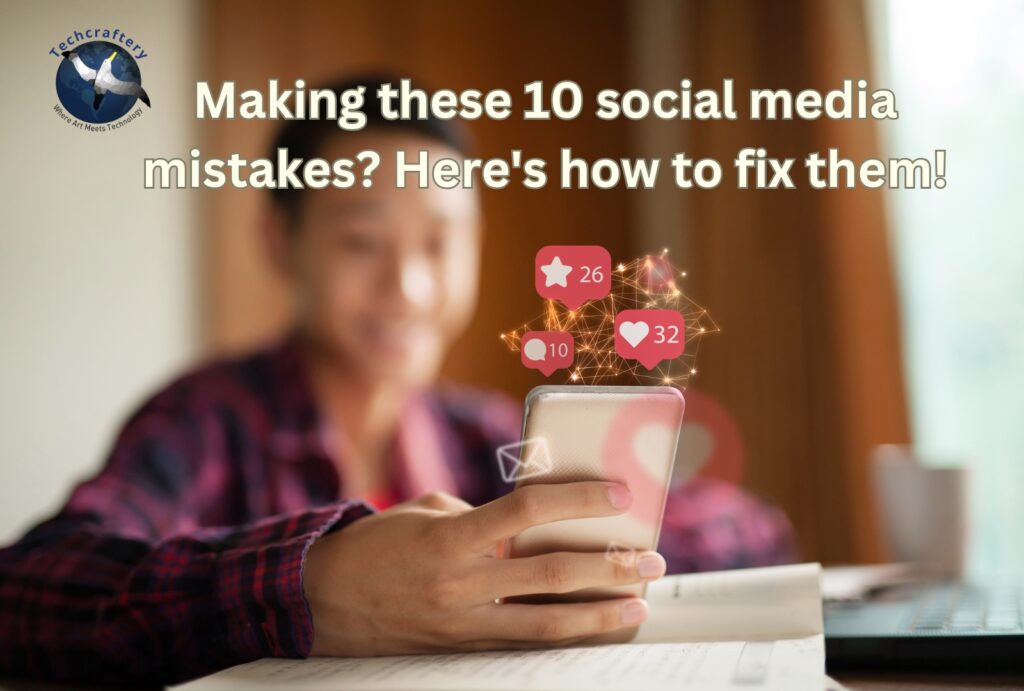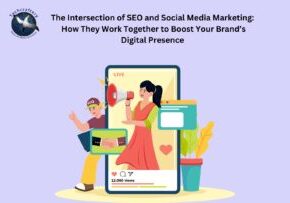Making these 10 social media mistakes? Here’s how to fix them!

Social media has become an essential part of both personal and professional life. It’s a space where we share our lives, connect with others, and, for businesses, market their products or services. However, despite its importance, many people still make avoidable mistakes that can hurt their online presence. Whether you’re an individual, an influencer, or a business owner, these mistakes can hinder your growth, damage your reputation, or even lead to negative consequences.
If you want to take full advantage of the opportunities social media offers, it’s crucial to avoid these common missteps. Let’s dive into 10 social media mistakes you might be making, and more importantly, how to fix them to ensure you’re using these platforms in the most effective way possible.
1. Neglecting to Define Your Audience
One of the biggest mistakes you can make on social media is not having a clear understanding of your target audience. Whether you’re posting for personal reasons, for business, or as an influencer, knowing who you’re trying to reach is crucial to shaping your content and engagement.
Why It’s a Mistake
Without a defined audience, your posts can become unfocused and irrelevant. You might be posting content that resonates with only a small portion of your followers, leading to low engagement and a disconnect between your messaging and your audience’s interests.
How to Fix It
Take the time to research and define your ideal audience. Consider factors like demographics (age, gender, location), interests, behaviors, and what problems or needs you can address through your content. Once you know who your audience is, tailor your posts to their preferences, pain points, and desires. Tools like Instagram Insights, Facebook Analytics, and Twitter Analytics can provide valuable data about your followers.
2. Overposting or Underposting
Both overposting and underposting can harm your social media strategy. Overposting floods your followers’ feeds and can make you seem spammy or desperate for attention, while underposting means you miss out on opportunities to stay top-of-mind.
Why It’s a Mistake
Overposting can irritate your audience, leading them to unfollow you or mute your posts. On the other hand, underposting can make you seem inactive or irrelevant, causing followers to lose interest or forget about you.
How to Fix It
Find a balance between quantity and quality. Most social media platforms, like Instagram, Facebook, and Twitter, thrive on consistent posting. Create a content calendar to ensure you’re posting at regular intervals, but not too often. For instance, posting once or twice a day on Instagram and three to five tweets a day on Twitter can keep you visible without overwhelming your audience. Tools like Buffer or Hootsuite can help schedule posts in advance and maintain consistency.
3. Ignoring Engagement
Social media isn’t just about posting content; it’s about engaging with your followers and building relationships. If you post content and don’t engage with your audience, you’re missing out on one of the key benefits of social media.
Why It’s a Mistake
When you ignore comments, messages, or mentions, it gives the impression that you don’t care about your audience, or you might come across as aloof. Social media is about two-way communication, not just broadcasting your message.
How to Fix It
Make time to engage with your followers by responding to comments, answering messages, and participating in conversations. Even simple interactions like liking comments or thanking followers for sharing your content can go a long way in building loyalty. Show your followers that you value their input, and they’ll be more likely to continue engaging with you.
4. Not Optimizing Your Profile
Your social media profile is often the first impression someone gets of you or your brand. If it’s incomplete or unappealing, people are likely to scroll past or unfollow.
Why It’s a Mistake
A poorly optimized profile gives the impression that you’re not serious or professional. It’s important to make sure your bio, profile picture, and contact details are clear, consistent, and reflective of your brand or personality.
How to Fix It
Update your bio with relevant information about who you are and what you do. Include a link to your website, portfolio, or any other relevant platform. Make sure your profile picture is high quality and aligns with your branding (e.g., a professional headshot for personal accounts, a logo for businesses). On platforms like Instagram, your highlights should reflect key aspects of your work or personality.
5. Posting Without a Strategy
Randomly posting without a clear plan is one of the quickest ways to waste time and energy on social media. A lack of strategy means you’re posting haphazardly without considering the bigger picture.
Why It’s a Mistake
Without a strategy, your content might lack purpose and fail to achieve your goals, whether it’s building brand awareness, increasing engagement, or driving sales. Posting aimlessly can lead to inconsistencies and missed opportunities to grow your online presence.
How to Fix It
Create a social media strategy that outlines your goals, target audience, content plan, and posting schedule. Decide what you want to achieve on each platform—whether it’s increasing website traffic, building a community, or raising brand awareness. Your content should align with these goals and be adapted to the specific platform you’re posting on. Analytics tools can help you track your performance and adjust your strategy over time.
6. Not Using Hashtags Properly
Hashtags are a powerful way to reach a larger audience, but many people use them incorrectly. Overusing or using irrelevant hashtags can actually hurt your visibility.
Why It’s a Mistake
If you use hashtags that are too generic or unrelated to your content, it’s less likely that the right people will discover your posts. Too many hashtags can also make your post look cluttered and spammy.
How to Fix It
Research the best hashtags for your niche and use a mix of popular and more specific ones. Use tools like Hashtagify or RiteTag to find relevant and trending hashtags. On Instagram, you can use up to 30 hashtags, but it’s generally recommended to use between 7 and 15 for a balanced approach. Keep your hashtags relevant to the content and your target audience.
7. Focusing Too Much on Numbers
It’s easy to get caught up in the numbers game—how many followers you have, how many likes you get, etc. However, focusing solely on metrics like follower count or engagement can be misleading and counterproductive.
Why It’s a Mistake
Chasing numbers can cause you to lose sight of the true value of social media. High numbers don’t always equate to real success. A small but engaged and loyal following is often more valuable than a large, disengaged audience.
How to Fix It
Shift your focus from vanity metrics to more meaningful metrics, such as engagement rate, conversion rate, and audience growth. Building a quality community of engaged followers is far more beneficial than simply aiming for a high follower count. Focus on creating meaningful content and fostering relationships with your audience.
8. Forgetting Mobile Optimization
With over 4.6 billion social media users worldwide, a large majority of them access platforms on mobile devices. If your content isn’t optimized for mobile viewing, you’re likely losing a significant portion of your audience.
Why It’s a Mistake
If your images, videos, or website links aren’t optimized for mobile, they may not display correctly on smaller screens, leading to a poor user experience. This can result in lower engagement, frustration, or people leaving your profile or website entirely.
How to Fix It
Ensure that all your content is mobile-friendly. Use high-resolution images that resize well on both desktop and mobile screens. Test your website or landing page’s mobile responsiveness. Most social platforms offer mobile previews of posts, so take advantage of this to ensure your content looks good before publishing.
9. Ignoring Analytics and Insights
Many users post content on social media without ever reviewing their performance analytics. Analytics are a powerful tool for understanding what works and what doesn’t, but ignoring them can prevent you from optimizing your content.
Why It’s a Mistake
Without analyzing your social media metrics, you can’t tell whether your content is effective or what kind of content resonates with your audience. By neglecting this information, you may continue creating content that doesn’t serve your goals or appeal to your audience.
How to Fix It
Use analytics tools on each social platform to track key metrics like engagement rate, reach, clicks, and follower growth. Tools like Google Analytics, Sprout Social, or Buffer can provide insights into how your social media efforts are driving traffic and conversions. Regularly review these metrics to adjust your strategy and improve your content.
10. Not Being Authentic
In today’s world, authenticity is more important than ever. Whether you’re a business or an individual, being overly polished or trying to fit into a mold can alienate your audience.
Why It’s a Mistake
When you aren’t authentic, people can sense it. Social media users value honesty and transparency, and they are more likely to engage with content that feels genuine. If you’re constantly pushing a “perfect” persona, you risk being perceived as fake or inauthentic.
How to Fix It
Show the real you! Share behind-the-scenes content, be open about your challenges, and let your personality shine through in your posts. If you’re representing a brand, focus on the core values and mission that resonate with your audience. Authenticity fosters trust, and trust leads to deeper relationships with your followers.










